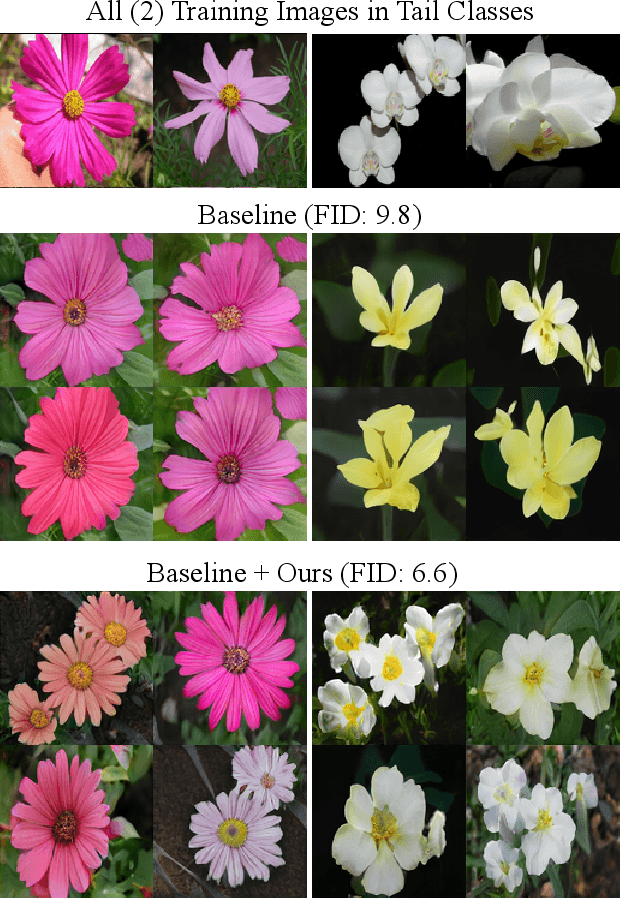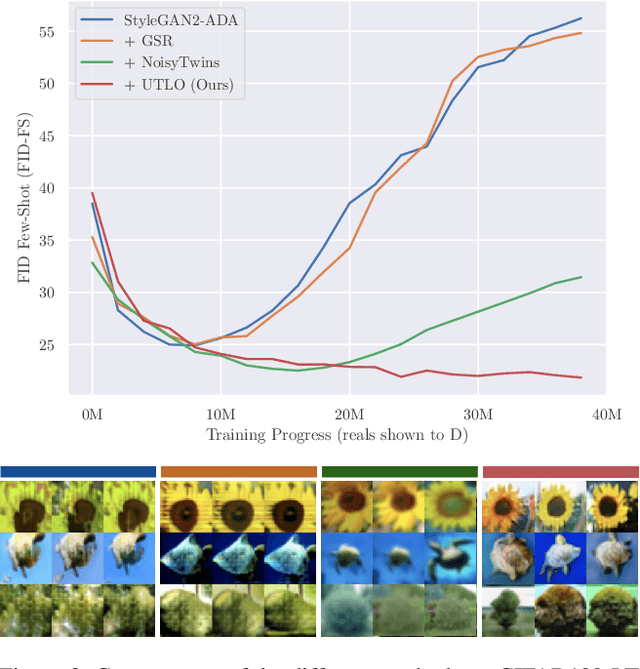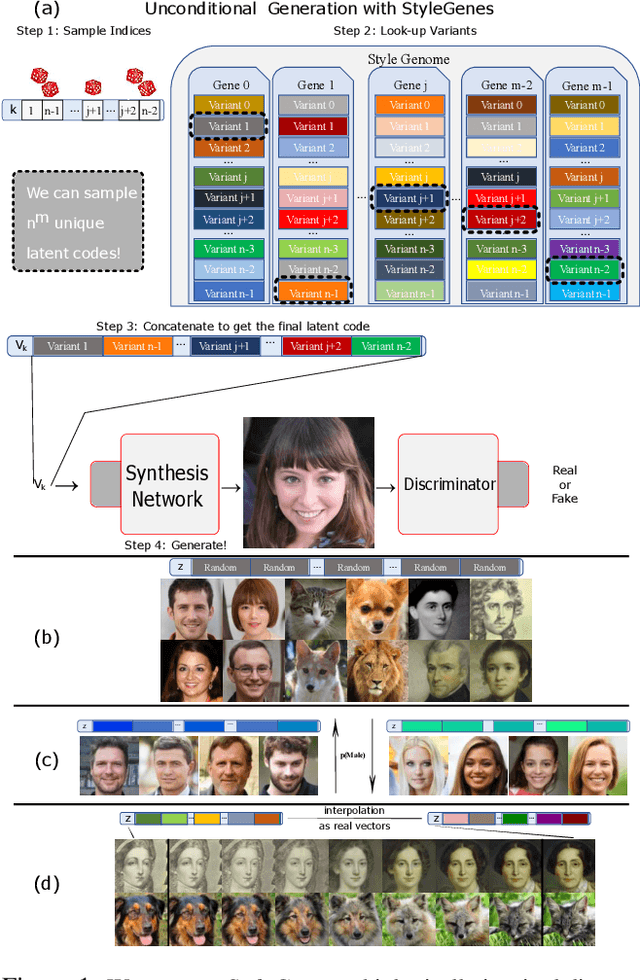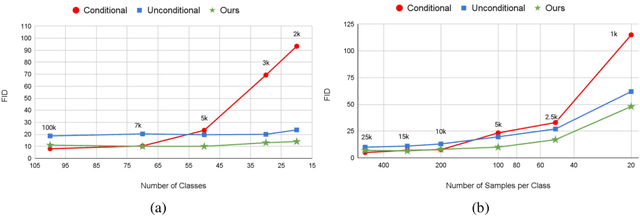Mohamad Shahbazi
Taming the Tail in Class-Conditional GANs: Knowledge Sharing via Unconditional Training at Lower Resolutions
Feb 26, 2024



Abstract:Despite the extensive research on training generative adversarial networks (GANs) with limited training data, learning to generate images from long-tailed training distributions remains fairly unexplored. In the presence of imbalanced multi-class training data, GANs tend to favor classes with more samples, leading to the generation of low-quality and less diverse samples in tail classes. In this study, we aim to improve the training of class-conditional GANs with long-tailed data. We propose a straightforward yet effective method for knowledge sharing, allowing tail classes to borrow from the rich information from classes with more abundant training data. More concretely, we propose modifications to existing class-conditional GAN architectures to ensure that the lower-resolution layers of the generator are trained entirely unconditionally while reserving class-conditional generation for the higher-resolution layers. Experiments on several long-tail benchmarks and GAN architectures demonstrate a significant improvement over existing methods in both the diversity and fidelity of the generated images. The code is available at https://github.com/khorrams/utlo.
InseRF: Text-Driven Generative Object Insertion in Neural 3D Scenes
Jan 10, 2024Abstract:We introduce InseRF, a novel method for generative object insertion in the NeRF reconstructions of 3D scenes. Based on a user-provided textual description and a 2D bounding box in a reference viewpoint, InseRF generates new objects in 3D scenes. Recently, methods for 3D scene editing have been profoundly transformed, owing to the use of strong priors of text-to-image diffusion models in 3D generative modeling. Existing methods are mostly effective in editing 3D scenes via style and appearance changes or removing existing objects. Generating new objects, however, remains a challenge for such methods, which we address in this study. Specifically, we propose grounding the 3D object insertion to a 2D object insertion in a reference view of the scene. The 2D edit is then lifted to 3D using a single-view object reconstruction method. The reconstructed object is then inserted into the scene, guided by the priors of monocular depth estimation methods. We evaluate our method on various 3D scenes and provide an in-depth analysis of the proposed components. Our experiments with generative insertion of objects in several 3D scenes indicate the effectiveness of our method compared to the existing methods. InseRF is capable of controllable and 3D-consistent object insertion without requiring explicit 3D information as input. Please visit our project page at https://mohamad-shahbazi.github.io/inserf.
StyleGenes: Discrete and Efficient Latent Distributions for GANs
Apr 30, 2023



Abstract:We propose a discrete latent distribution for Generative Adversarial Networks (GANs). Instead of drawing latent vectors from a continuous prior, we sample from a finite set of learnable latents. However, a direct parametrization of such a distribution leads to an intractable linear increase in memory in order to ensure sufficient sample diversity. We address this key issue by taking inspiration from the encoding of information in biological organisms. Instead of learning a separate latent vector for each sample, we split the latent space into a set of genes. For each gene, we train a small bank of gene variants. Thus, by independently sampling a variant for each gene and combining them into the final latent vector, our approach can represent a vast number of unique latent samples from a compact set of learnable parameters. Interestingly, our gene-inspired latent encoding allows for new and intuitive approaches to latent-space exploration, enabling conditional sampling from our unconditionally trained model. Moreover, our approach preserves state-of-the-art photo-realism while achieving better disentanglement than the widely-used StyleMapping network.
NeRF-GAN Distillation for Efficient 3D-Aware Generation with Convolutions
Mar 22, 2023Abstract:Pose-conditioned convolutional generative models struggle with high-quality 3D-consistent image generation from single-view datasets, due to their lack of sufficient 3D priors. Recently, the integration of Neural Radiance Fields (NeRFs) and generative models, such as Generative Adversarial Networks (GANs), has transformed 3D-aware generation from single-view images. NeRF-GANs exploit the strong inductive bias of 3D neural representations and volumetric rendering at the cost of higher computational complexity. This study aims at revisiting pose-conditioned 2D GANs for efficient 3D-aware generation at inference time by distilling 3D knowledge from pretrained NeRF-GANS. We propose a simple and effective method, based on re-using the well-disentangled latent space of a pre-trained NeRF-GAN in a pose-conditioned convolutional network to directly generate 3D-consistent images corresponding to the underlying 3D representations. Experiments on several datasets demonstrate that the proposed method obtains results comparable with volumetric rendering in terms of quality and 3D consistency while benefiting from the superior computational advantage of convolutional networks. The code will be available at: https://github.com/mshahbazi72/NeRF-GAN-Distillation
DiffDreamer: Consistent Single-view Perpetual View Generation with Conditional Diffusion Models
Nov 22, 2022Abstract:Perpetual view generation -- the task of generating long-range novel views by flying into a given image -- has been a novel yet promising task. We introduce DiffDreamer, an unsupervised framework capable of synthesizing novel views depicting a long camera trajectory while training solely on internet-collected images of nature scenes. We demonstrate that image-conditioned diffusion models can effectively perform long-range scene extrapolation while preserving both local and global consistency significantly better than prior GAN-based methods. Project page: https://primecai.github.io/diffdreamer .
A Continual Deepfake Detection Benchmark: Dataset, Methods, and Essentials
May 14, 2022



Abstract:There have been emerging a number of benchmarks and techniques for the detection of deepfakes. However, very few works study the detection of incrementally appearing deepfakes in the real-world scenarios. To simulate the wild scenes, this paper suggests a continual deepfake detection benchmark (CDDB) over a new collection of deepfakes from both known and unknown generative models. The suggested CDDB designs multiple evaluations on the detection over easy, hard, and long sequence of deepfake tasks, with a set of appropriate measures. In addition, we exploit multiple approaches to adapt multiclass incremental learning methods, commonly used in the continual visual recognition, to the continual deepfake detection problem. We evaluate several methods, including the adapted ones, on the proposed CDDB. Within the proposed benchmark, we explore some commonly known essentials of standard continual learning. Our study provides new insights on these essentials in the context of continual deepfake detection. The suggested CDDB is clearly more challenging than the existing benchmarks, which thus offers a suitable evaluation avenue to the future research. Our benchmark dataset and the source code will be made publicly available.
Arbitrary-Scale Image Synthesis
Apr 05, 2022Abstract:Positional encodings have enabled recent works to train a single adversarial network that can generate images of different scales. However, these approaches are either limited to a set of discrete scales or struggle to maintain good perceptual quality at the scales for which the model is not trained explicitly. We propose the design of scale-consistent positional encodings invariant to our generator's layers transformations. This enables the generation of arbitrary-scale images even at scales unseen during training. Moreover, we incorporate novel inter-scale augmentations into our pipeline and partial generation training to facilitate the synthesis of consistent images at arbitrary scales. Lastly, we show competitive results for a continuum of scales on various commonly used datasets for image synthesis.
Collapse by Conditioning: Training Class-conditional GANs with Limited Data
Jan 17, 2022



Abstract:Class-conditioning offers a direct means of controlling a Generative Adversarial Network (GAN) based on a discrete input variable. While necessary in many applications, the additional information provided by the class labels could even be expected to benefit the training of the GAN itself. Contrary to this belief, we observe that class-conditioning causes mode collapse in limited data settings, where unconditional learning leads to satisfactory generative ability. Motivated by this observation, we propose a training strategy for conditional GANs (cGANs) that effectively prevents the observed mode-collapse by leveraging unconditional learning. Our training strategy starts with an unconditional GAN and gradually injects conditional information into the generator and the objective function. The proposed method for training cGANs with limited data results not only in stable training but also in generating high-quality images, thanks to the early-stage exploitation of the shared information across classes. We analyze the aforementioned mode collapse problem in comprehensive experiments on four datasets. Our approach demonstrates outstanding results compared with state-of-the-art methods and established baselines. The code is available at: https://github.com/mshahbazi72/transitional-cGAN
Efficient Conditional GAN Transfer with Knowledge Propagation across Classes
Feb 12, 2021



Abstract:Generative adversarial networks (GANs) have shown impressive results in both unconditional and conditional image generation. In recent literature, it is shown that pre-trained GANs, on a different dataset, can be transferred to improve the image generation from a small target data. The same, however, has not been well-studied in the case of conditional GANs (cGANs), which provides new opportunities for knowledge transfer compared to unconditional setup. In particular, the new classes may borrow knowledge from the related old classes, or share knowledge among themselves to improve the training. This motivates us to study the problem of efficient conditional GAN transfer with knowledge propagation across classes. To address this problem, we introduce a new GAN transfer method to explicitly propagate the knowledge from the old classes to the new classes. The key idea is to enforce the popularly used conditional batch normalization (BN) to learn the class-specific information of the new classes from that of the old classes, with implicit knowledge sharing among the new ones. This allows for an efficient knowledge propagation from the old classes to the new classes, with the BN parameters increasing linearly with the number of new classes. The extensive evaluation demonstrates the clear superiority of the proposed method over state-of-the-art competitors for efficient conditional GAN transfer tasks. The code will be available at: https://github.com/mshahbazi72/cGANTransfer
 Add to Chrome
Add to Chrome Add to Firefox
Add to Firefox Add to Edge
Add to Edge